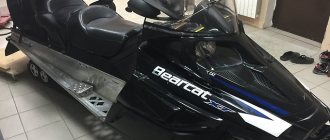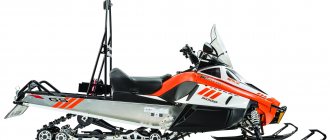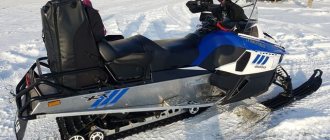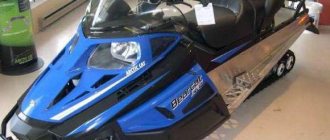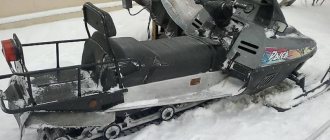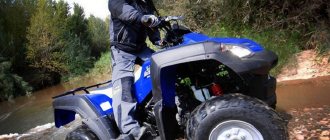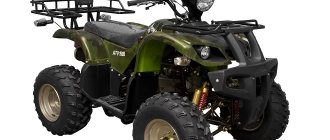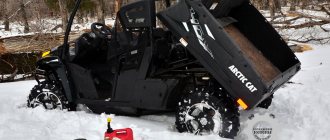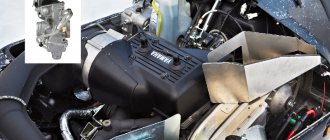The Arctic Cat Bearcat 570XT is a multi-purpose snowmobile with basic off-road capabilities. This model is among the most inexpensive representatives of utilitarian snowmobiles from an American manufacturer. The model under consideration has an undeniable advantage - a simplified design that is easy to maintain in the field. According to this indicator, the Arctic Cat 570XT model is no worse than more technologically advanced and expensive utilitarian snowmobiles, which are characterized by special requirements for reliability and safety. The American apparatus is best adapted to a wide variety of conditions, and therefore it is not surprising that it has become widespread in regions most remote from civilization. Let's take a closer look at what explains the global success of the Arctic Bat 570XT.
The machine is designed on the basis of a modern chassis. The developers installed a proprietary Articulating Rear Suspension with moving elements. Special components of the rear suspension increased the strength and endurance of the track propulsion system, and at the same time the entire chassis. Let us note another important feature - the ability to adjust the suspension to certain road conditions in order to improve cross-country ability and reduce the degree of wear of parts. The machine is equipped with a track width of 510 mm, which is standard for most utilitarian machines. Thanks to such a wide track, characteristics such as directional stability and geometric cross-country ability are improved. As a result, this made it possible to position the car as a vehicle for driving on virgin snow or compacted snow, as well as on a frozen body of water. In general, this device is able to overcome any obstacles.
As for the front suspension, here the developers also introduced their own proprietary component - this is the American-made AWS VII proprietary suspension, which features reinforced A-arms. This arrangement had a beneficial effect on handling and cornering speed. At the same time, the device remains as stable as possible while moving, even when maneuvering between trees. Moving actively in forested areas is an easy task for this snowmobile, which means that unlocking its handling potential depends only on the professional training of the driver.
Of no small importance is the innovative Twin Spar chassis, developed using box side members made of high-strength aluminum. These side members combine the steering mounts with the tunnel side members to improve reliability and protect against damage. All chassis elements are connected together using high-strength rivets, which are also a component for increasing the level of rigidity.
Video
The front part of the structure is reinforced with a massive bumper that protects against frontal collisions. Of course, there is the same bumper at the rear of the car.
It is noteworthy that the Arctic Cat Bearcat 570 XT snowmobile can accommodate two people including the driver, but if necessary, the second seat can be removed, and this procedure is completed in a matter of minutes. Removing the passenger seat frees up space for securing a small cargo container. Moreover, the Arctic Cat Bearcat 570XT snowmobile officially supports the transportation of not only two, but also three passengers - all you need to do is install an additional seat. The three-seater layout in the snowmobile is ensured through the use of a rail mounting system, which is very convenient and practical.
The vehicle of the same name is equipped with a small luggage compartment, which is located under the driver's seat. In this compartment you can store spare parts and necessary tools that may be needed to troubleshoot various problems in the field. The luggage compartment is completely sealed and protected from damage and moisture.
The Arctic Cat 570 XT snowmobile received a multifunctional instrument panel with an analog display necessary for transmitting all data related to the operation of the equipment - this is the current speed, remaining fuel, a signal about possible overheating of the internal combustion engine, ambient temperature readings, engine crankshaft speed, readings of kilometers traveled (daily mileage), as well as indicators for reverse gear and hazard lights.
Price
The basic version of the Arctic Cat Bearcat 570 costs 550 thousand rubles. For 610 thousand rubles. You can buy an Artiquet with an expanded configuration, including an enlarged windshield, ski extensions, an additional passenger seat (making the snowmobile a three-seater), a beacon, snow clearing equipment, a winch, a heated power plant, heated seats, and a transverse stabilizer bar.
A used model will cost 380,000-390,000 rubles. The cost of a used car is affected by the number of engine hours and general technical condition. Used equipment usually requires repair. Here are approximate prices for some spare parts suitable for the Arctic Cat Bearcat 570 XT (cost in rubles):
| Variator bearing bushing | 2640 |
| Radiator protection in tunnel | 2154 |
| Exhaust manifold | 1526 |
| Brake pads | 2350 |
| Oil filter | 390 |
| Gearbox gear assembly | 15880 |
| Drive shaft sprocket | 2650 |
| Spark plug | 1490 |
| Transmission chain damper | 1190 |
| Roller (skating rink) | 2750 |
Specifications
- Dimensions, mm: Length – 3480, Ski track width – 1118
- Front suspension – AWS VII with two hydraulic shock absorbers
- Rear suspension – Articulating Rear Suspension, articulated, with adjustable leaf springs
- Diameter of rear shock absorbers – 50 mm
- Rear Link – Torque Sensing Link
- Front/rear suspension travel – 216/330 mm
- Propulsion - caterpillar type, with front drive sprockets
- Caterpillars, pcs. - 1
- Tension mechanism – screw
- Caterpillar belt – reinforced, rubber-fabric
- Track length – 3910 mm
- Track width – 510 mm
- Height of lugs – 35 mm
- Transmission - variator, with low and high gears, with reverse and neutral speed
- Brakes – disc, hydraulic
- Starter – manual, electronic
- Ignition – capacitor (CDI)
- Lubrication system – electronic, with oil injection
- Snowmobile weight – 290 kg
- Mass of towed cargo container – 500 kg
- Fuel tank volume – 64 liters
- Layout – two- or three-seater
- Exhaust – exhaust pipe with muffler
Basic equipment elements:
Electric starter, reverse, heated steering wheel grips and throttle trigger, high windshield, backrest for the passenger seat, rear towbar, odometer and speedometer, halogen headlight, LED taillight.
Chassis system
The Arctic Cat Bearcat 570 XT uses a state-of-the-art Articulating Rear Suspension. Its end part is movable, thanks to which the manufacturer managed to increase the service life of the tracked propulsion unit and chassis. This feature made it possible to significantly increase the vehicle's cross-country ability.
The width of the running belt is 510 mm, which is typical for most modern utilitarian snowmobiles. Such a caterpillar has a positive effect on the vehicle’s maneuverability both on compacted snow and on the surface of a frozen reservoir.
The manufacturer equipped the snowmobile with a modern front suspension model AWS™ VII, which includes powerful and durable A-arms. Thanks to this, excellent controllability of the vehicle when cornering was achieved, as well as stable movement on a straight section. Maneuvering between trees in forest areas is also not a problem for the Arctic Cat 570.
The Twin Spar™ chassis is built around two aluminum box spars. They connect the steering mounts and tunnel rails together. A special feature is the use of high-strength rivets that connect all chassis elements into one. In addition, the chassis has an increased level of rigidity and, of course, durability.
Engine
The Arctic KET 570 snowmobile is equipped with a two-stroke gasoline engine. The power unit has a two-cylinder layout, with crankshaft speeds of up to 7300 rpm. The rated power is 62 horsepower, and the diameter of each of the two cylinders is 73 mm. The working volume of the cylinders is 565 cubic meters. The unit has a high level of safety and is protected from overheating and hypothermia. To do this, the engine has a continuously running air cooling system, which maintains a stable temperature of the internal combustion engine components. This is very important in warm or frosty weather.
Advantages and disadvantages of Arctic Cat Bearcat machines
Owners of the unpretentious Bearcat 750 snowmobile noted a number of advantages:
- Significant load capacity. The device, released in 2009, can carry up to 500 kg of cargo.
- Power and reliability. The Arctic snowmobile is designed for long trips.
- Compactness. The width of the device is 132 cm and the length is 325 cm.
- Comfortable. The comfortable seat makes the ride pleasant, and the open trunk allows you to store a lot of things.
Of course, it was not without its drawbacks. The owner will have to tinker with the starter and traction. But one visit to the workshop will be enough to solve possible problems.
Reviews
- Sergey, Leningrad region. I've been using this snowmobile for almost a year. At the first stage I had good impressions of the car. The device is quite light and maneuverable, with a wide track and excellent maneuverability. You can even overcome deep snowdrifts. At first I was even delighted with this American car - I was almost convinced that I had made the right choice in favor of imported equipment. But it turned out I was wrong. Despite the high cost, after about six months of intensive use the first problems began to appear. Suddenly, the fuel level sensor, which was attached to the gas tank cap, fell off. Then I discovered later that the sensor had fallen into the fuel tank. Another problem was problems with the electric starter, so I had to use a manual starter. The car consumes a lot of fuel, since the engine is two-stroke. You also need to regularly refill with high-quality oil. Its volume is as much as 64 liters - apparently, the developers knew in advance about the problem with increased consumption. It is inconvenient to engage gears, almost like on a Viking. Overall, I think that this American is no better than the Russian snowmobiles that I have ever ridden.
- Maxim, Irkutsk. For our harsh winters we had to buy a high-quality and expensive snowmobile. It turned out to be the Arctic Cat 570XT, which was ideal for my needs. I have been interested in fishing since childhood. Mine moves excellently on a frozen lake, and I consider this a significant advantage. I was also pleased with the presence of a large windshield that protects from gusts of oncoming wind. For greater comfort and convenience, you can turn on the heated steering wheel grips, and then you can generally drive without gloves. I’ll also note one interesting detail, thanks to which this compact snowmobile becomes a three-seater - with the help of a special insert that is inserted when the second seat is moved away, and as a result another seat is formed. At the same time, the load on the chassis increases significantly (when transporting three people). But the suspension can withstand such a load thanks to powerful springs that increase rigidity and endurance. As for the interior, it surprised me no less than the rideability of the snowmobile. The same goes for the appearance – the snowmobile looks stylish and dynamic from the front and back. In general, this model impressed me in all respects.
- Alexey, Magnitogorsk. A great snowmobile for all occasions during the winter season. This car combines everything - quality, practicality, technology, design and ergonomics, handling, reliability and other parameters. The car drives quietly and smoothly, it is very good for hunting and at work. The snowmobile confidently climbs the hill and rides like a real utilitarian snowmobile. In general, in this device I found something in common between a mountain and a utilitarian snowmobile. I will recommend it to my friends. I have been using the car for two years, during which time I have not had a single serious breakdown.
- Denis, Ekaterinoslavl. A nice snowmobile with a classic appearance and great capabilities. The main thing is just not to forget to service it. After all, the slightest breakdown can develop into a serious malfunction, due to which this American can ruin my entire family budget. But seriously, the car is really expensive to maintain. It is better to use only original parts, including branded consumables, oil and fuel. I've been using it for a year and a half, so far so good. One of the minor shortcomings was the failure of the reverse speed switch, and at the most unexpected moment. The model is ideal for riding with the family, as well as hunting and fishing needs. I ride this snowmobile with my grandfather and son, maybe even three of us. The car behaves well on slippery roads - for example, on a frozen icy lake. Against this background, the small lug is somewhat overshadowed, which is sometimes not enough to overcome powdery snow, or climb a hill.
temperature sensor
Many people who study thematic forums and at least somehow think about the proper operation of equipment have heard how many copies have been broken around the control of engine temperature conditions. So for a long time I could not decide what to do and what to do. In the end, I just went and ordered what I had my heart set on - a device that measures the temperature of the exhaust gases.
This is a two-channel Koso Dual EGT Meter. Why not under the spark plugs? Yes, it’s just that the difference in price with the same CITD is no longer so psychologically great, but it is not the average temperature of the large heat capacity of the cylinder head that is measured, and even through the thermal resistance of the material of the immediately forcibly blown ring of the semiconductor sensor, but precisely what happened literally a moment ago - gases almost at the edge of the exhaust window. What does this give? Yes, at least I am confident that I will see exactly the instantaneous temperature values, and not the readings from under the candle integrated with a sufficiently large time constant of the metal mass. Installing the sensors themselves is quite simple and does not require special qualifications, because all you need to do is disassemble the spring-loaded joints of the resonator and unscrew four nuts from the cylinder block studs, drill two holes in the pants and reassemble everything in the reverse order.
I don’t know how deep the sensors should be recessed; intuitively, in other conditions, it would be more correct to be two-thirds of the pipe diameter or even a little less, but I stuck it to the maximum. I think it’s not important, because from a sharp expansion the temperature of the gases drops much faster than from cooling by the walls of the outlet pipe.
The main thing here is not to rest against the casing and ensure ease of installation at the closest possible distance from the cylinders.
The manufacturer recommends four inches from the exhaust port, and I was able to meet this requirement.
You can lay the wires based on your own preferences, their length allows you to do this as you like, but I secured it to the frame on the left side with steel brackets, you never know, plastic ties tend to burst over time. A small digression related to questions already received on the topic. In particular, about the price of devices and their differences. As far as I understand, the Koso Dual EGT Meter indicators themselves are all the same, the difference in price is doubled - the sellers' wishes or something else, but not in the filling or settings. But there is a nuance: the equipment. There are only two of them, these are Koso Dual EGT Meter with Standard EGT Sensors Part number BA006B61 and Dual EGT Meter with Fast-Response EGT Sensors Part number BA006B61X. Their difference is in the sensors. The fast-reacting one differs from the standard one only in that the temperature-sensitive element - a thermocouple - is not placed in a protective housing and, as a result, has almost zero thermal inertia, and therefore responds to temperature changes instantly.
Do you see a droplet at the end of the probe? This is a thermocouple. A reasonable question arises: why do we need this? Are we building graphs to analyze rapidly changing thermal processes with a high-speed recorder? No. Moreover, the device itself polls the sensors a couple of times per second. So why pay more, especially for a thermocouple that is not protected by a closed housing? I currently have the following sensor:
There are places on the Internet where rumors are spread that devices with a scale in Celsius are noticeably more expensive than those in Fahrenheit. I was all tense, waiting for the parcel. But, no - the scale is selected by simply pressing a button. Those who don’t believe you can look at the instructions, everything is written there in English in black and white. But, we digress, let's move on. Now let's mount the indicator itself. It was more convenient for me to place it to the left of the instrument panel, but to the right of it is the navigator.
Connection
The age-old dilemma is connections. Since our ignition switch is essentially not one at all, you can only connect to it with a pin, which, when the cable is pulled out, does the same thing as turning the key to zero - it closes the ignition system to ground with its contacts. Therefore, we simply connect with a pin in parallel with contacts 1 and 2 of the ignition switch connector:
The complete diagram sheet is here. True, I have a four-pin connector, so it’s better to check with a tester which one is responsible for what, and not trust to blind chance. There is, as we see, a permanent plus on the contact that is locked, but why do we need it? To set the toggle switch anyway? I wanted to automate the process of turning on additional devices and even soldered a small gadget:
This is nothing more than a full-wave rectifier on a db107 diode bridge, at the input of which two black wires are soldered in blue heat shrink according to the photo, and at the output - in parallel, a low-current coil of an electromagnetic relay SRSB-12VDC-SL-C and a smoothing capacitor 1000uF/50V. In theory, being connected to the additional load connector (there is a changeover), the same one that dangles near the battery and the main one - and the only one! - a standard fuse; when the engine starts, this rectifier supplies a relay with direct current, which closes our new circuit directly from the battery without any toggle switches. Which is exactly what is needed. Let's see what we have there.
But why fence the garden even with such trifles? It is enough to look at the electrical diagram again and check with a tester just two wires going to the standard instrument panel, the connector of which is located in the most advantageous place for us:
The black one here is ground, but the red one with a blue stripe is the circuit after the relay regulator. That is, a circuit where +12V appears only after the engine is started, and not from the generator rectifier, but stabilized ones. Well, as much as a crude relay-regulator can stabilize such a brutal apparatus as a snowmobile, but this is quite enough for us. In the diagram these are pins 1 and 2.
I have already posted the full sheet of this diagram above, and here is another, general one. At any speed, the voltage is stable, except that at low idle it can drop to less than ten, which leads to Montana switching to its battery, but this is a direct path to adjusting the idle speed. It is advisable to make all connections to the on-board network detachable, and through fuses it is absolutely necessary. I connected the cigarette lighter directly to the battery terminals through a separate fuse. In corrugation, with all precautions along the laying route, tea, permanent connection:
Cigarette lighter and check
Since I was taking apart everything that could be taken apart, primarily out of curiosity, I decided to install at the same time the cigarette lighter socket with the engine emergency stop check. Somehow I got used to it on a boat, and even on inexpensive devices, but here it just asks for it. Ordering small things over the hill and then waiting a month is not my thing, so I bought everything I needed at a fishing store. True, it’s more expensive than on ebay, and that’s okay: a cigarette lighter costs four hundred rubles, about seven hundred for a pin with a cable.
How it all turned out - I didn’t take it off, apparently I forgot, but here you can see a little of the cable, the cigarette lighter, and the pin:
